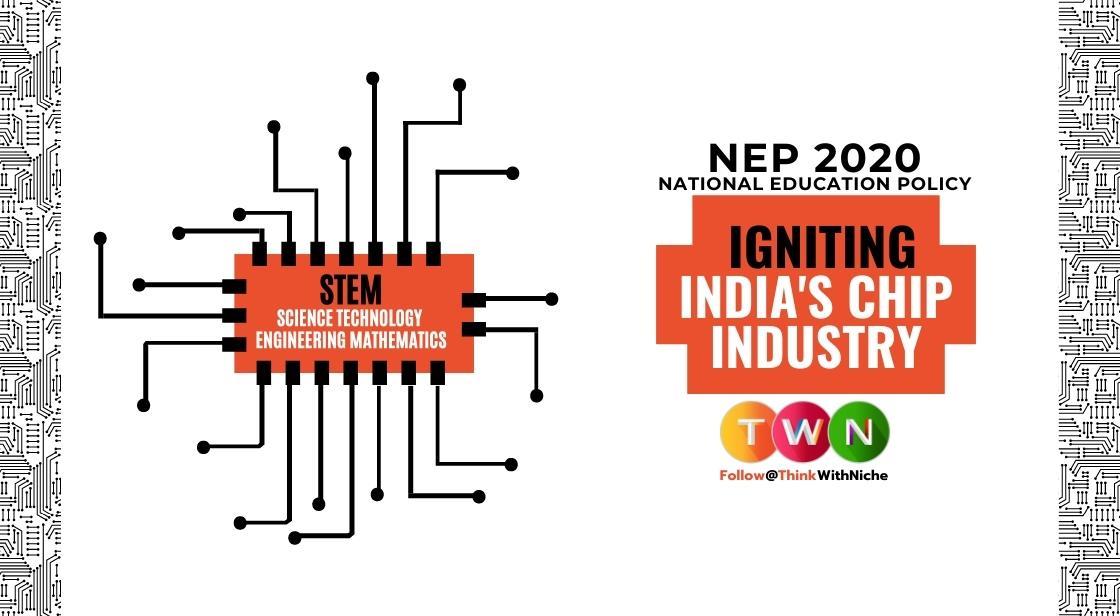Igniting India's Chip Industry: Unleashing Potential through the National Education Policy's Focus on STEM

Blog Post
STEM education plays a pivotal role in driving technological advancements and catalyzing economic growth, particularly in the semiconductor and electronics sectors.
As India aims to establish itself as a leading player in these fields, the National Education Policy has taken a forward-thinking approach by embracing multidisciplinary learning, fostering creativity, and promoting collaborations between academia and industry.
This strategic focus on STEM education will ultimately pave the way for building a skilled and innovative workforce, essential for driving progress in the semiconductor and electronics industries.
The Indian government's recent announcement of the National Education Policy (NEP) has brought renewed focus on STEM education in India. The policy aims to transform the Indian education system by placing greater emphasis on science, technology, engineering, and mathematics (STEM) subjects.
This move is particularly significant for India's ch ip industry, which has long struggled to keep up with global competition. The NEP's emphasis on STEM education could prove to be a game-changer for India's chip industry, unlocking its potential to become a global player in the semiconductor industry.
In this blog post, we will explore the NEP's focus on STEM education, its potential impact on India's chip industry, and how it could help India establish a foothold in the global semiconductor market.
The recent announcement of the National Education Policy (NEP) in India has sparked renewed excitement and hope for the country's chip industry. With a strong emphasis on Science, Technology, Engineering, and Mathematics (STEM) education, the NEP aims to transform India's educational landscape and ignite innovation from an early age.
In this blog post, we delve into the potential impact of the NEP on India's chip industry, exploring the significance of STEM education in fostering innovation and economic growth. We also discuss the challenges faced by the chip industry and highlight the critical need for a skilled workforce to drive advancements in this sector.
Introduction to India's chip industry and its potential
India's chip industry has long been recognized as a promising sector with immense potential. With the recent implementation of the National Education Policy (NEP), which emphasizes Science, Technology, Engineering, and Mathematics (STEM) education, the stage is set for a major transformation in this industry.
The NEP aims to ignite innovation and propel India's technological advancements by nurturing a strong foundation in STEM education from the grassroots level.
The chip industry, also known as the semiconductor industry, plays a critical role in the development of various cutting-edge technologies. From smartphones and computers to automobiles and medical devices, semiconductors form the backbone of modern-day electronics.
Currently, India heavily relies on imports to meet its semiconductor demands, making it crucial to unlock the potential of the domestic chip industry.
One of the key objectives of the NEP is to foster a culture of research and innovation in STEM fields. By focusing on early education and providing quality resources and training, the policy aims to nurture young minds and equip them with the necessary skills to excel in the chip industry. This strategic move not only creates a pathway for India to become self-reliant in semiconductor manufacturing but also positions the nation as a global hub for technological innovation.
The potential benefits of a flourishing chip industry in India are immense. It would not only reduce the dependence on imports but also generate employment opportunities and contribute significantly to the country's economy.
Moreover, it would pave the way for indigenous research and development, leading to groundbreaking discoveries and inventions.
As the NEP sets the stage for a paradigm shift in India's educational landscape, it is crucial to explore the potential of the chip industry and the role it can play in shaping the nation's future.
This blog post aims to delve into the various aspects of India's chip industry, highlighting its potential impact on technological advancements and economic growth.
By unleashing the power of STEM education and nurturing a thriving chip industry, India can truly position itself as a global leader in innovation and pave the way for a brighter future.
Overview of the National Education Policy's focus on STEM education
The National Education Policy (NEP) of India has set forth a transformative vision aimed at revolutionizing the country's education system. One of the key aspects of this policy is its explicit emphasis on STEM (Science, Technology, Engineering, and Mathematics) education.
With an aim to ignite India's chip industry and unleash its immense potential, the NEP recognizes the critical role of STEM education in equipping students with the necessary skills and knowledge to thrive in the 21st-century economy.
Under the NEP, STEM education is seen as a catalyst for fostering innovation, creativity, and problem-solving abilities among students. It seeks to cultivate a strong foundation in science and mathematics from an early age, enabling students to develop a deep understanding of these subjects.
By integrating technology and engineering principles into the curriculum, the NEP aims to nurture a generation of skilled individuals who can drive advancements in various sectors, including the chip industry.
Moreover, the NEP emphasizes the need for hands-on learning experiences and practical application of STEM concepts. It encourages the establishment of well-equipped laboratories and the use of technology-enabled teaching methods to enhance students' engagement and comprehension.
By promoting experiential learning, the policy intends to bridge the gap between theoretical knowledge and real-world implementation, thus preparing students for the challenges and opportunities of the chip industry.
Furthermore, the NEP recognizes the importance of collaboration and interdisciplinary learning in STEM education. It encourages schools and higher education institutions to establish partnerships with industry experts, research organizations, and other stakeholders.
Such collaborations can provide students with exposure to the latest technological advancements, industry practices, and research opportunities, fostering a culture of innovation and entrepreneurship.
The significance of STEM education in fostering innovation and economic growth
STEM education plays a crucial role in fostering innovation and driving economic growth. With the implementation of the National Education Policy in India, there is a renewed focus on Science, Technology, Engineering, and Mathematics (STEM) subjects, aiming to ignite the country's chip industry and unleash its potential.
STEM education equips students with the knowledge and skills needed to excel in the modern world. It nurtures critical thinking, problem-solving abilities, and creativity, all of which are essential for innovation.
By engaging students in hands-on activities and real-world applications, STEM education encourages curiosity and a passion for discovery.
In today's rapidly evolving technological landscape, industries are increasingly reliant on advancements in science and technology. By emphasizing STEM education, India can cultivate a talented pool of individuals who possess the skills necessary to meet the demands of the future job market.
It not only creates a workforce that is equipped with technical expertise but also encourages a culture of innovation and entrepreneurship.
Moreover, investing in STEM education has broader implications for economic growth. It paves the way for the development of a robust and sustainable chip industry, which is integral to various sectors such as telecommunications, electronics, healthcare, and manufacturing.
By nurturing a skilled workforce in the field of chip design and manufacturing, India can reduce its dependence on imports, promote indigenous innovation, and contribute to the country's economic development.
The National Education Policy's focus on STEM education is a significant step towards building a knowledge-based economy.
By instilling a strong foundation in science and technology from an early age, students can explore their interests, develop specialized skills, and pursue careers in cutting-edge industries.
This emphasis on STEM education not only benefits individuals but also strengthens India's position as a global leader in technology and innovation.
Also Read: Driving Circular Economy Forward: Empowering Change through Upcycling Innovations
Challenges faced by India's chip industry and the need for skilled workforce
The chip industry in India has witnessed tremendous growth in recent years. However, it faces several challenges that hinder its full potential. One of the major challenges is the scarcity of a skilled workforce. The complex nature of chip manufacturing requires individuals with expertise in various fields such as electronics, computer science, and engineering.
Currently, there is a shortage of professionals with the necessary skills and knowledge to contribute effectively to the chip industry.
This shortage can be attributed to the lack of emphasis on STEM (Science, Technology, Engineering, and Mathematics) education in India's education system. Many students are not adequately exposed to these subjects, resulting in a limited pool of talent for the chip industry.
Another challenge is the rapid pace of technological advancements in the chip industry. As technology evolves, new skills and knowledge become essential to keep up with the changing landscape.
Without a skilled workforce that is adaptable and up-to-date with the latest developments, the Indian chip industry may struggle to compete globally.
To address these challenges, the National Education Policy (NEP) in India has placed a strong focus on STEM education. The NEP aims to enhance the quality of education in these fields and promote a culture of innovation and research among students.
By integrating STEM education into the curriculum, students will have a solid foundation in science and technology, preparing them for careers in the chip industry.
Additionally, the NEP emphasizes the importance of vocational training and skill development.
This will enable students to acquire practical skills and hands-on experience, making them job-ready for the chip industry. With a skilled workforce that understands the complexities of chip manufacturing, India can overcome the challenges it faces and unlock the full potential of its chip industry.
Analysis of the National Education Policy's initiatives to promote STEM education
The National Education Policy of India has laid a strong emphasis on promoting STEM (Science, Technology, Engineering, and Mathematics) education in the country.
This visionary policy recognizes the potential of STEM in driving innovation, economic growth, and global competitiveness. In this section, we will analyze some of the key initiatives outlined in the policy that aim to ignite India's chip industry and unleash its full potential.
One of the major initiatives is the integration of STEM education throughout the curriculum from an early age. The policy recognizes the importance of nurturing scientific and analytical thinking from a young age and aims to introduce age-appropriate STEM modules in schools.
This holistic approach to education will help develop a strong foundation in STEM subjects and create a pipeline of talented individuals who can contribute to the chip industry.
Moreover, the National Education Policy also emphasizes the need to establish specialized STEM schools and centers of excellence. These institutions will provide world-class education, state-of-the-art infrastructure, and specialized training in STEM fields.
By creating a conducive environment for learning and innovation, these institutions will nurture young minds and equip them with the necessary skills and knowledge to excel in the chip industry.
Another significant aspect of the policy is the focus on industry-academia collaboration. Recognizing the importance of bridging the gap between theoretical knowledge and practical application, the policy encourages partnerships between educational institutions and the chip industry.
This collaboration will facilitate knowledge sharing, research collaborations, and internship opportunities, enabling students to gain real-world exposure and hands-on experience in the chip industry.
Furthermore, the National Education Policy proposes the establishment of research and development centers and incubation hubs to promote innovation and entrepreneurship in the chip industry.
These centers will serve as platforms for researchers, scientists, and entrepreneurs to collaborate, ideate, and develop cutting-edge technologies.
Such initiatives will not only boost indigenous chip manufacturing but also attract global investments and collaborations, positioning India as a global hub for chip technology.
How the policy aims to bridge the skill gap in the chip industry
The National Education Policy (NEP) in India has recognized the urgent need to bridge the skill gap in the chip industry. With the exponential growth of technology and the increasing demand for skilled professionals in the semiconductor domain, the NEP has taken a significant step towards unleashing the potential of India's chip industry.
Under the NEP, there is a strong emphasis on Science, Technology, Engineering, and Mathematics (STEM) education. The policy aims to foster a strong foundation in STEM subjects from an early age, enabling students to develop critical thinking, problem-solving skills, and a deep understanding of the core concepts in these fields.
To bridge the skill gap in the chip industry, the NEP proposes the establishment of specialized STEM schools and centers of excellence. These institutions will provide advanced training and education in areas such as microelectronics, semiconductor design, fabrication, and testing.
By focusing on practical skills and hands-on learning, these institutions will ensure that students are equipped with the necessary expertise to excel in the chip industry.
Furthermore, the NEP also emphasizes the importance of industry-academia collaborations. It encourages partnerships between educational institutions and chip companies to facilitate knowledge sharing, internships, and research collaborations. This will not only provide valuable exposure to students but also allow them to gain real-world experience and stay updated with the latest industry trends.
In addition to academic initiatives, the NEP promotes the creation of innovation hubs and incubation centers. These platforms will serve as a breeding ground for innovative ideas and startups in the chip industry.
By providing the necessary infrastructure, mentorship, and funding, these centers will nurture entrepreneurship and drive innovation in the semiconductor sector.
Overall, the NEP's focus on STEM education and its initiatives to bridge the skill gap in the chip industry are crucial steps towards igniting India's chip industry.
By equipping students with the right knowledge, skills, and opportunities, India can position itself as a global leader in semiconductor technology, attracting investments, creating job opportunities, and driving economic growth.
Collaborations between academia, industry, and government to promote chip manufacturing
Collaboration between academia, industry, and government plays a crucial role in promoting chip manufacturing in India. The National Education Policy's focus on STEM education provides a strong foundation for building a skilled workforce in the semiconductor industry.
However, to truly unleash the potential of India's chip industry, it is essential to establish robust partnerships between these key stakeholders.
Academia has a crucial role to play in nurturing talent and equipping students with the necessary knowledge and skills. Collaborations with industry leaders can provide students with real-world insights, practical training, and access to cutting-edge technologies.
By aligning their curriculum with industry requirements, educational institutions can ensure that graduates are job-ready and capable of contributing to the growth of the chip industry.
Industry, on the other hand, can offer invaluable support through mentorship programs, internships, and collaborative research projects. By actively engaging with academia, companies can help shape the future workforce and bridge the gap between theoretical education and practical application.
This collaboration can also facilitate knowledge transfer, innovation, and the development of indigenous technologies.
Government support is crucial in creating an enabling environment for chip manufacturing. This can be achieved through policies that incentivize investment, promote research and development, and provide infrastructure support. By establishing research parks, incubation centers, and funding mechanisms, the government can encourage collaboration between academia and industry.
Additionally, the government can facilitate partnerships between domestic and international companies, fostering technology transfer and attracting investment in the chip manufacturing sector.
The synergistic collaboration between academia, industry, and government creates a powerful ecosystem that fosters innovation, drives economic growth, and positions India as a global player in the chip industry.
By leveraging the National Education Policy's emphasis on STEM education and fostering strong partnerships, India can ignite its chip industry's potential and pave the way for technological advancements, job creation, and sustainable development.
It is crucial to celebrate and share such success stories to inspire other students, educators, and policymakers to embrace STEM education and invest in the development of India's chip industry.
By empowering students in STEM fields and providing them with the necessary resources and opportunities, we can unleash the untapped potential of India's youth, leading to a thriving and globally competitive chip industry.
The role of entrepreneurship and start-ups in driving innovation in the chip industry
Entrepreneurship and start-ups play a pivotal role in driving innovation in any industry, and the chip industry is no exception. With the National Education Policy's focus on STEM education, there is a tremendous opportunity for aspiring entrepreneurs to make a significant impact on India's chip industry.
Start-ups in the chip industry have the potential to disrupt the market with their innovative ideas and solutions. They can introduce new technologies, develop cutting-edge products, and challenge the status quo.
These start-ups are often fueled by the passion and drive of young entrepreneurs who are not afraid to take risks and explore uncharted territories.
One key advantage that start-ups have is their agility and ability to adapt quickly to changing market demands. They have the freedom to experiment, iterate, and pivot their strategies based on feedback and market insights. This flexibility allows them to stay ahead of established players and bring novel solutions to the market.
Furthermore, start-ups can act as a catalyst for collaboration and partnerships within the chip industry. They can forge alliances with established companies, academic institutions, and research organizations to leverage their expertise and resources. Such collaborations can facilitate knowledge sharing, access to funding, and enable a faster pace of innovation.
The government's support for start-ups through initiatives like Start-up India and Atmanirbhar Bharat provides a conducive environment for entrepreneurs in the chip industry.
The availability of venture capital funds, incubation centers, and mentorship programs further fuel the growth of start-ups, enabling them to scale their operations and make a significant impact on the industry.
Conclusion: The potential impact of the National Education Policy in igniting India's chip industry and shaping its future
The National Education Policy's focus on STEM has the potential to ignite India's chip industry and shape its future in remarkable ways. By emphasizing science, technology, engineering, and mathematics education, the policy aims to equip students with the skills and knowledge needed to thrive in the digital age.
The chip industry plays a crucial role in India's technological advancement, and with the right support and resources, it has the potential to become a global leader. The policy's emphasis on hands-on learning, critical thinking, and problem-solving will nurture the next generation of innovators and entrepreneurs in the field of chip manufacturing.
Moreover, the policy's commitment to promoting research and development, encouraging industry-academia collaboration, and fostering entrepreneurship will create a fertile ecosystem for the growth of the chip industry. This, in turn, will attract investment, drive job creation, and spur economic growth in India.
However, realizing the full potential of the National Education Policy requires concerted efforts from all stakeholders, including the government, educational institutions, industry leaders, and the wider community. Adequate funding, infrastructure development, and skilled faculty are essential to provide quality education and training in the field of chip manufacturing.
By leveraging the opportunities presented by the National Education Policy, India can harness its abundant talent pool and become a global powerhouse in the chip industry. This will not only drive technological innovation but also contribute to the country's socio-economic development.
You May Like
EDITOR’S CHOICE












